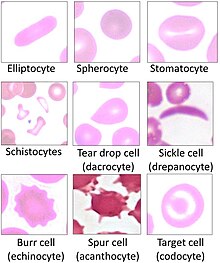Spherocytosis
| Spherocytosis | |
|---|---|
 | |
| Spherocytosis seen in a peripheral blood smear from a patient with hereditary spherocytosis | |
| Specialty | Hematology |
Spherocytosis is the presence of spherocytes in the blood, i.e. erythrocytes (red blood cells) that are sphere-shaped rather than bi-concave disk shaped as normal. Spherocytes are found in all hemolytic anemias to some degree. Hereditary spherocytosis and autoimmune hemolytic anemia are characterized by having only spherocytes.[1]
Causes
Spherocytes are found in immunologically-mediated hemolytic anemias and in hereditary spherocytosis, but the former would have a positive direct Coombs test and the latter would not. The misshapen but otherwise healthy red blood cells are mistaken by the spleen for old or damaged red blood cells and it thus constantly breaks them down, causing a cycle whereby the body destroys its own blood supply (auto-hemolysis). A complete blood count (CBC) may show increased reticulocytes, a sign of increased red blood cell production, and decreased hemoglobin and hematocrit. The term "non-hereditary spherocytosis" is occasionally used, albeit rarely.[2]
Lists of causes:[3]
- Warm autoimmune hemolytic anemia
- Cold autoimmune hemolytic anemia/paroxysmal cold hemoglobinuria
- Acute and delayed hemolytic transfusionreactions
- ABO hemolytic diseases of newborn/Rh hemolytic disease of newborn
- Hereditary spherocytosis
- Intravenous water infusion or drowning (fresh water)
- Hypophosphatemia
- Bartonellosis
- Snake bites
- Hyposplenism
- Rh-null phenotype
Pathophysiology
Spherocytosis most often refers to
In short, spherocytosis has an attribute of decreased cell deformability.[4]
Diagnosis

Spherocytosis can be diagnosed in Peripheral blood film by seeing spherical red blood cells rather than biconcave. Because spherical red blood cells are more prone to lysis in water (because they lack some proteins in their cytoskeleton) there will be increased osmotic fragility on acidified glycerol lysis test.[citation needed]
Treatment
Treatment may vary depending on the cause of the condition. In the case of hereditary spherocytosis, although research is ongoing, at this point there is no cure for the genetic defect that causes hereditary spherocytosis.[5] Current management focuses on interventions that limit the severity of the disease. Treatment options for this type of spherocytosis include:
- Splenectomy: As in non-hereditary spherocytosis, acute symptoms of meningococcus, and prophylactic antibiotic treatment. However, the use of prophylactic antibiotics, such as penicillin, remains controversial.[5]
- Partial splenectomy: Since the spleen is important for protecting against encapsulated organisms, sepsis caused by encapsulated organisms is a possible complication of splenectomy.[7] The option of partial splenectomy may be considered in the interest of preserving immune function. Research on outcomes is currently limited,[7] but favorable.[8]
- Surgical removal of the gallbladder may be necessary.[5]
See also
References
- ISBN 978-0-07-144035-6. Retrieved 15 November 2010.
- S2CID 43340793.
- ISBN 978-0781770231.)
{{cite book}}:|first1=has generic name (help)CS1 maint: multiple names: authors list (link - PMID 18988878.
- ^ ]
- S2CID 5870305.
- ^ S2CID 5870305.
- PMID 21238662.
